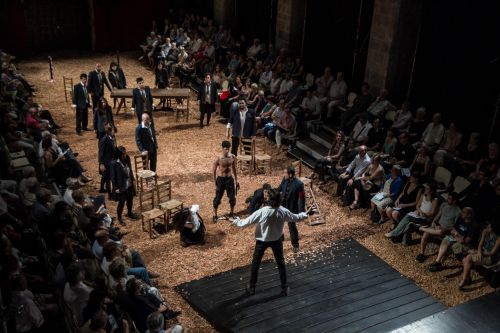 Spain R. Wagner: Das Liebesverbot, Cadaquès Orchestra, Palau de la Música Catalana’s Chamber Chorus,Fausto Nardi (conductor), Perelada Castle’s Church, 4.8.2013 (JMI).
Spain R. Wagner: Das Liebesverbot, Cadaquès Orchestra, Palau de la Música Catalana’s Chamber Chorus,Fausto Nardi (conductor), Perelada Castle’s Church, 4.8.2013 (JMI).

Photo EDDY KELELE
Production: Festival Castell de Perelada
Direction: Georgios Kapoglou
Sets and costumes: Peter Sommerer
Lighting: Marco Philipp
Cast:
Isabella: Julia Farrés-Llongueras
Dorella: Rocío Martínez
Marianna: Mercedes Gancedo
Friedrich: Alex Sanmartí
Luzio: David Alegret
Claudio: Vicenç Esteve Madrid
Brighella: Enric Martínez-Castignani
Pontio Pilato: Marc Rendón.
Das Liebesverbot, also known as Die Novize von Palermo, is the first opera that Richard Wagner premiered, although not the first opera he wrote: that was Die Feen (The Fairies) which was never performed in Wagner’s lifetime. The premiere of Das Liebesverbot took place in Magdeburg in 1836 and it was such a huge fiasco that it too was not staged until after Wagner’s death. Few have been the occasions where the opera has been revived at all. Among them it should be noted the most successful of all was productions was conducted by Wolfgang Sawallisch in Munich in 1983 to celebrate the centenary of the composer’s death. It seems that the second centenary of the birth of Richard Wagner has made more than one opera house look back to these first Wagner operas. Now that Das Liebesverbot has been perfromed, as it was last month, albeit in concert form, at the Sports Palace in Bayreuth, others may follow. This includes the Perelada Festival which decided to program it in what is certainly the absolute premiere of the opera in Spain.
Das Liebesverbot is a comic opera that follows the tradition of French and Italian opera of its time, but occasionally, here and there, the mature Wagner appears. Any opera afcionado could identify passages reminiscent of Tannhäuser and even Tristan. The opera is easy to listen to, with some attractive arias, duets and ensembles, and certainly it does not deserve to have fallen into complete oblivion. In my opinion its biggest problem lies, as in many other Wagner operas, in the libretto, written as always by the composer himself. The original opera is over 4 hours long. Sawallisch and Ponnelle, on the above mentioned occasion in Munich, made the right decision to make cuts and it was, as such, reduced to 2 hours and 35 minutes. The one performed at Perelada included additional cuts so that in total it is something short of 2 hours. What we lost in music, we gained in agility.
The Perelada Festival offered a shortened version of the opera, not only in its length, but also in its orchestration, using a score for small chamber orchestra that Frank Böhme made for the Festival of Young Artists at Bayreuth in 2005. Here the orchestra of 15 musicians was well suited for the small space of the church. The performance was done in ther central nave with seats along the sides of the church. The orchestra itslef was placed at the altar. The space neeed, as you can imagine, was so small that it would be a difficult transition for this orchestral and vocal version to play in a big house.
The staging by Georgios Kapoglou was more a semi-staged than a fully staged production. There were no sets, only a space where soloists and extras move, and where there was little else but some chairs and a table. The costumes were quite simple and reflected the styles of the 70s. What does stand out though is the stage direction. Mr. Kapaglou did a great job with the whole group of young singers, choristers and extras. It was a perfect example of how to do much with very little. The opera was sung in German with dialogues in Catalan.
The musical direction was in the hands of Italian Fausto Nardi. Both the director and the orchestra fulfilled their mission although the sound lacked brightness. Nevertheless, I must say that both the musical and stage directions resulted in a very lively performance. The Chamber Choir was quite good as were their voices as the secondary characters in the opera. All the singers showed a rare intensity as if they themselves were living the characters lives.
Catalan soprano Julia Farrés-Llongueras was a remarkable Isabella, having both an attractive voice, with a good deal of expressiveness, and an attractive figure on stage. The most important voice in the cast was baritone Alex Sanmartí in the character of Friedrich. This singer would have no problems being heard in a large house as he has proved in the past both at Liceu and Bilbao. His singing, though is often loud and short of nuances, and as a result can become rather monotonous.
The other females in the cast succeeded in their roles: Rocio Martinez made for a remarkable interpreter of Dorella and Mercedes Gancedo did well in the second act aria of Marianna.
David Alegret who played the part of Luzio had a small voice, but handled it well as is usual in his case. The other tenor, Vicenç Esteve Madrid, had to deal with the almost impossible role of Claudio yet was still somehow convincing. Enric Martínez-Castignani was well suited to Brighella, the Chief of Police.
The Iglesia del Carmen had a capacity of some 320 seats and was about 90% filled. The audience gave an excellent reception to all the singers.
José Mª. Irurzun